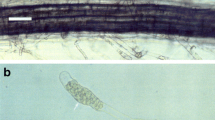Abstract
The infection processes of ascospores and pycnidiospores of Leptosphaeria maculans were studied on cotyledons of six cultivars of spring-type Brassica napus: one with resistance controlled by a single dominant gene (cv. Surpass 400), three with polygenic resistance (cvs. Dunkeld, Grouse, and Outback), and two susceptible cultivars (Westar and Q2). On all cultivars, ascospore germination, penetration, and development of symptoms on cotyledons were much earlier than that with pycnidiospores. At 2 h after inoculation ascospores began to germinate, by 4 h about 50% had germinated, and by 6–8 h 85%–90% had germinated. In contrast, pycnidiospores began to germinate 1 day after inoculation (dai) and reached only 50% germination by 3 dai. Ascospores began germinating from terminal cells and then later from the interstitial cells. Pycnidiospores germinated predominantly from one end and sometimes from both ends. Germ tubes from ascospores penetrated stomata as early as 4 h after inoculation, whereas those from pycnidiospores penetrated at 2 dai. Symptom development with ascospores was 2 days earlier than that with pycnidiospores. Symptoms on Surpass 400 were evident as early as 3–5 dai with ascospores and 5–7 dai with pycnidiospores. However, on other cultivars, symptoms were not evident until 10 dai with ascospores and 12 dai with pycnidiospores. This report is the first on differences in the infection processes by the two spore types. Ascospore and pycnidiospore attachment, germination, and penetration did not differ between resistant and susceptible cultivars, but there were major differences after penetration. Under high humidity, 80%–90% of stomata of susceptible Westar and Q2 had aerial hyphae emerging from stomatal pores. However, fewer stomata (5%–10%) had aerial hyphae on Surpass 400 by 10 dai with ascospores and 12 dai with pycnidiospores, but even these were usually poorly developed. Host differences in spring-type B. napus in relation to production of aerial hyphae have not previously been reported. In Surpass 400, rapid necrosis of guard cells occurred within a few hours of penetration by either type of spore, and subsequently one or a few cells immediately adjacent to the penetration site died. This necrosis then spread to the cells around the penetration site to form a hypersensitive response (in the form of a small, dark lesion) to both ascospores and pycnidiospores. This is the first detailed report on interactions between spring-type B. napus and L. maculans in relation to single dominant gene-based resistance. Neither the cultivars with polygenic resistance nor the susceptible cultivars had such a response.
Similar content being viewed by others

Author information
Authors and Affiliations
Corresponding author
Rights and permissions
About this article
Cite this article
Li, H., Sivasithamparam, K., Barbetti, M. et al. Germination and invasion by ascospores and pycnidiospores of Leptosphaeria maculans on spring-type Brassica napus canola varieties with varying susceptibility to blackleg. J Gen Plant Pathol 70, 261–269 (2004). https://doi.org/10.1007/s10327-004-0125-8
Received:
Accepted:
Issue Date:
DOI: https://doi.org/10.1007/s10327-004-0125-8



